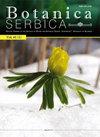On Bangia atropurpurea (Bangiales, Rhodophyta), the strictly protected red alga in Serbia
IF 1.1
4区 生物学
Q4 PLANT SCIENCES
引用次数: 3
Abstract
The first observation of the red alga Bangia atropurpurea (Bangiales, Rhodophyta) in Serbia was in 1991 in the Trgoviski Timok River (Eastern Serbia). From 1991 to 2017, the species was sporadically observed at four more locations in three hillmountain rivers in Southwestern (the Gvozdacka River and the Raska River) and Eastern (the Nisava River - two localities) Serbia. More intensive research on this alga was carried out from 2017 to 2020, and a total of 220 localities in 132 hillmountain watercourses were studied. Bangia atropurpurea was recorded at six locations in Southwestern and Eastern Serbia. Five of these locations represent new B. atropurpurea localities in Serbia (the Brusnicka River, the Golijska Moravica River, the Panjica River, the Resava River, and the second locality in the Trgoviski Timok River), while one of them is already known from previous studies (the Raska River). The species was found in running, moderately hard and very hard, well-oxygenated, slightly alkaline waters, mainly low in inorganic nutrients, and in highly variable values of temperature and conductivity. Despite the long period since its first observation in Serbian rivers, the species is still known in a small number of localities. The small number of localities, low relative abundance, and various anthropogenic influences affecting its habitats have led the species to be recognized as endangered and strictly protected in Serbia. The intensive development of small hydropower plants which have emerged in recent years may threaten B. atropurpurea habitats.关于在塞尔维亚受到严格保护的红藻——孟加拉红藻
1991年在塞尔维亚的Trgoviski Timok河(塞尔维亚东部)首次观察到红藻Bangia atropurpurea (Bangiales, Rhodophyta)。从1991年到2017年,在塞尔维亚西南部(Gvozdacka河和Raska河)和东部(Nisava河-两个地方)的三条丘陵河流的另外四个地点偶尔观察到该物种。2017年至2020年,对132条丘陵河道的220个地点进行了深入研究。在塞尔维亚西南部和东部的6个地点记录了阿托普雷亚。其中五个地点代表了塞尔维亚境内新的B. atropurpurrea地点(Brusnicka河、Golijska Moravica河、Panjica河、Resava河和Trgoviski Timok河中的第二个地点),而其中一个地点已经从以前的研究中已知(Raska河)。该物种生长于流动、中硬和极硬、富氧、微碱性、无机营养物质含量低、温度和电导率变化大的水体中。尽管在塞尔维亚的河流中首次观察到该物种已经有很长一段时间了,但在少数地方仍然知道该物种。由于地点数量少,相对丰度低,以及影响其栖息地的各种人为影响,该物种已被确认为濒危物种,在塞尔维亚受到严格保护。近年来出现的小型水电站的集约化开发可能会威胁到白桦生境。
本文章由计算机程序翻译,如有差异,请以英文原文为准。
求助全文
约1分钟内获得全文
求助全文
来源期刊

Botanica Serbica
Agricultural and Biological Sciences-Plant Science
CiteScore
1.40
自引率
12.50%
发文量
17
审稿时长
34 weeks
期刊介绍:
Botanica Serbica publishes original research papers on all aspects of plant, fungal and microbial biology research including the disciplines of microbiology, mycology, lichenology, bryology, flora, vegetation, biogeography, systematics, taxonomy, plant biotechnology, plant cell biology, plant ecology, environmental plant biology, forestry, genomics, horticulture, limnology, metabolomics, molecular biology, proteomics, virology, plant conservation and protection, and wildlife and ecosystem management.
 求助内容:
求助内容: 应助结果提醒方式:
应助结果提醒方式:


